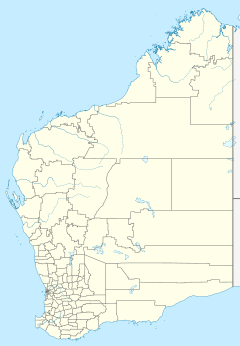18°11′17″S 127°29′56″E / 18.188°S 127.499°E

Moola Bulla Station is a pastoral lease that operates as a cattle station in the Kimberley region of Western Australia. It is approximately 20 kilometres (12 mi) west of Halls Creek and 150 kilometres (93 mi) south of Warmun, and occupies an area of 6,600 square kilometres (2,548 sq mi).[1] It bisects the watershed of the Fitzroy River and Ord Rivers.[2]
Moola Bulla was established in 1910[3] as a government-run station for the punishment[clarification needed] of Aboriginal people,[4] and remains an area that indigenous peoples avoid.[1][5][6] With increasingly bloody conflict between Aborigines and pastoralists, it was hoped that opening a ration station would reduce the need for Aborigines to kill livestock for food, and that they could instead be trained for work on other cattle stations.[3] The station was acquired for £18,061, and a manager and staff were appointed.[7] The station was proclaimed a reserve and used as a camping ground for the local Aboriginal peoples, who were free to come and go as they pleased. The property's name is Aboriginal [which language?] for meat plenty.[7]
By 1912, the property carried a herd of approximately 12,000 head of cattle, and the following year turned off 650 head and slaughtered 400 head for their own consumption.[8] In 1916, it occupied an area of 2,000 square miles (5,180 km2), about 50 miles (80 km) long and 40 miles (64 km) wide.[9]
The homestead was stocked with 13,000 head of cattle and 500 head of horses in 1916. In 1917 the property recorded over 20 inches (508 mm) rain, far above the average of the previous few years and guaranteeing a good next season.[10]
By 1920 the property occupied an area of 6,475 square kilometres (2,500 sq mi) and was stocked with 14,000 cattle. Employees of the station numbered close to 260, of which seven were of European descent.[2] Aboriginal people such as young artist Daisy Andrews and her family, originally from the Walmajarri desert tribe, were sent to work at the station by authorities to prevent them from returning to their former tribal lands.[11]
In 1955, the state government sold the station[12] to Queensland pastoralist Allan Goldman for £100,000.[13] When Goldman bought Moola Bulla station, its 200 Aboriginal residents were given 24 hours to leave, and Moola Bulla sent truckloads[quantify] of them to United Aborigines Mission at Fitzroy Crossing.[14] Goldman sold the station two years later, for £150,000, to a syndicate of investors including Northern Territory grazier H. J. Mortimer.[15]
Peter Camm had been poised to buy the station, but the deal fell through when he was charged with cattle theft. The property was then acquired in 2001 by a syndicate of investors, including Andrew Cranswick, for A$18 million. In 2006, the syndicate sold it to agribusiness company Great Southern Group for an estimated A$30 million.[1]
Following Great Southern Group's 2009 collapse, Moola Bulla was sold in 2010 to its former part-owner, the South African Western Australian Pastoral Company (also owner of Beefwood Park) for A$20 million, with 25,000 head of cattle.[16]
In December 2014, the pastoral lease, along with Mt. Amhurst, Beefwood Park and Shamrock Stations, was to become part of Gina Rinehart's Liveringa Station Beef company, pending approval of higher stock numbers by the Western Australian Pastoral Board. However, the deal fell through.[17]
In November 2016, the pastoral lease, along with Mt. Amhurst, Beefwood Park and Shamrock Stations, was sold to Consolidated Australian Pastoral Holdings (CAPH).[18]
See also
editReferences
edit- ^ a b c Aja Styles (7 July 2011). "The curse of Moola Bulla station strikes again". WA Today. Fairfax Media. Retrieved 24 November 2014.
- ^ a b "5,000 miles tour". The West Australian. Perth: National Library of Australia. 29 June 1920. p. 7. Retrieved 25 November 2014.
- ^ a b Beth Neate (19 March 2012). "Now and Then: Moola Bulla Station". Australian Broadcasting Corporation. Retrieved 24 November 2014.
- ^ Rumley, Hilary; Toussaint, Sandy (1990), "'For Their Own Benefit'?: A Critical Overview of Aboriginal Policy and Practice at Moola Bulla, East Kimberley, 1910–1955", Aboriginal History, 14: 80–103, ISSN 0314-8769
- ^ Achoo, Henry; Moola Bulla Oral History Project; Kimberley Language Resource Centre; Achoo, Henry; et al. (1996), Moola Bulla : in the shadow of the mountain, Magabala Books, ISBN 978-1-875641-17-8
- ^ Moola Bulla Oral History Project; Kimberley Language Resource Centre (1900), [Series of oral history interviews], retrieved 26 November 2014
- ^ a b "The Aborigines". Western Mail. Perth: National Library of Australia. 15 July 1911. p. 51. Retrieved 25 November 2014.
- ^ "The Western Argus". Kalgoorlie Western Argus. Western Australia: National Library of Australia. 13 May 1913. p. 16. Retrieved 25 November 2014.
- ^ "A trip through Kimberley". The West Australian. Perth: National Library of Australia. 8 August 1916. p. 9. Retrieved 25 November 2014.
- ^ "Big Rainfall". The Daily News. Perth: National Library of Australia. 16 February 1917. p. 8. Retrieved 25 November 2014.
- ^ "Munmarria Daisy Andrews - Red was for blood, sacrifice and Aboriginal loss". The Sydney Morning Herald. 6 April 2015. Retrieved 4 August 2018.
- ^ "Moola Bulla Lookout". Halls Creek – The heart of the Kimberley. 2011. Retrieved 24 November 2014.
- ^ Western Australia (1955), Moola Bulla station in the East Kimberley District : particulars and conditions of sale, Govt. Pr, retrieved 24 November 2014
- ^ Westralian gems for Christ's crown by S Preston Walker, 2001, p.61
- ^ "Moola Bulla for sale". The Canberra Times. Australian Capital Territory: National Library of Australia. 6 June 1957. p. 2. Retrieved 24 November 2014.
- ^ "Moola Bulla Station sold". Australian Broadcasting Corporation. 17 December 2010. Retrieved 23 November 2014.
- ^ Babs McHugh (26 November 2014). "Mining magnate Gina Rinehart close to finalising deal to buy more Kimberley cattle stations as she expands Western Australian beef empire". ABC Rural. Australian Broadcasting Corporation. Retrieved 26 November 2014.
- ^ "Settlement completed on $100m Kimberley cattle land deal". Beef Central. 17 November 2016. Retrieved 16 December 2022.
